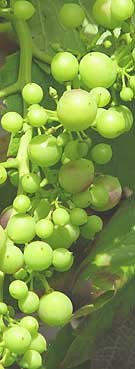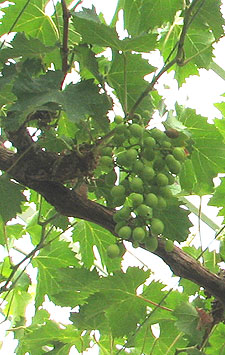Growing Grapes in a Greenhouse
VARIETIES OF GRAPE TO GROW IN AN UNHEATED GREENHOUSE
Buckland Sweetwater: Large slightly oval green grapes which ripen to a greenish gold. Juicy and very sweet.
Foster's Seedling: Very sweet tender green gold easy to grow grapes which mature in late summer to early autumn.
Black Hamburgh: The most commonly grown indoor grape - has large black sweet and juicy fruits.

VARIETIES OF GRAPEVINE TO GROW IN A HEATED GREENHOUSE
In addtion to the varieties of vine listed above the following varieties of grape do better in a heated greenhouse.
Muscat of Alexandria: A late variety with sweet golden grapes.Does not set well.
Mrs Pince: Black Muscat grape that can be grown outside, but which ripens much earlier in a greenhouse.
Madresfield Court: A juicy black Muscat grape which produces large bunches of large fruits.
Alicante: Large black grape which matures in mid autumn.
GROWING GUIDES

SOCIETIES
A Guide to Growing Dessert Grapes in a Greenhouse
 Grapes
are usually considered to be a warm climate fruit, and it is true that
they prefer long, hot summers in order to ripen fully.
Grapes
are usually considered to be a warm climate fruit, and it is true that
they prefer long, hot summers in order to ripen fully.
Nevertheless, the best quality dessert grapes are grown in greenhouses in temperate climates. These shy-setting varieties of grape, particularly the Muscats, set fruit best in the artificial conditions of a greenhouse.
Although you can grow wine varieties of grapevines in a greenhouse, it is more sensible to use your greenhouse for the sweeter and more delicate dessert varieties, producing high quality grapes which you would not be able to grow successfully outdoors.
GROWING GRAPES ALONGSIDE TOMATOES AND CUCUMBERS
Unfortunately, grapes dislike the growing conditions preferred by most other greenhouse crops, such as tomatoes and cucumbers.
GROWING GRAPES IN A SPECIALIZED VINERY
To get first-class grapes, you really need a specialized vinery where
an ideal environment can be maintained. But do not worry if you cannot
afford to devote a whole green-
house to grapes; you should succeed in producing moderate crops of all
but the most delicate varieties in the normal, home gardener’s mixed greenhouse.
Once established, a vine will produce good crops for a small amount of effort. A single vine, trained as a long rod, will give you a bunch of grapes every week for three months.
PREPARING THE BORDER
 Vines like to spread their roots, but you will get heavier crops if
you restrict this tendency; if you allow the root free rein, the vine
will produce a lot of vegetative growth at the expense of fruit. By confining
the roots to a prepared border, you can better regulate the amount of
water and nutrients the plants receive.
Vines like to spread their roots, but you will get heavier crops if
you restrict this tendency; if you allow the root free rein, the vine
will produce a lot of vegetative growth at the expense of fruit. By confining
the roots to a prepared border, you can better regulate the amount of
water and nutrients the plants receive.
This is definitely the best way of growing greenhouse grapes, as it ensures a balance between root and shoots throughout the life of the vine, and prevents the nearby soil becoming ‘sour’ and infertile.
Good drainage is the most essential feature of a satisfactory vine border.
If you are planting the vines indoors, the border should ideally be about 1.5 metres by 3 metres for each vine, although you can produce quite good grapes with smaller borders.
Dig out the soil to a depth of 75 cm keeping the topsoil and subsoil separate, and fill the bottom with 15—25 cm of rubble to provide a drainage layer.
Cover this layer either with turves laid upside down, or with about 15 cm depth of straw, to prevent the soil percolating down into the drainage layer and blocking it.
Then return the soil to the border, mixing it with two 12 Litre buckets of rotted manure and 120 grams of bonemeal per plant, making sure that the topsoil goes back on top.
Tread the soil down lightly as it is returned, so there is not too much subsidence later.
Border preparation should be done two to three months before planting, to give the soil time to settle naturally.
OUTDOOR BORDERS
If your greenhouse space is limited, and you wish to grow other plants as well as grapes, then it is a better idea not to plant the vine indoors at all, but to plant it outdoors and train the above-ground portion into the greenhouse through a hole in the wall.
Although vine roots appreciate the cooler temperatures of outdoor life, the cropping will probably not be as heavy as completely indoor- grown grapes, because you cannot really restrict the root run to any extent.
Remove a brick from the greenhouse ‘wall at ground level where you want the vine to enter; temporarily block the hole with straw or newspaper until you come to train the vine through it. Then prepare the outside border as you would for an inside border.
PLANTING A GRAPEVINE
The number of vines you plant and their spacing depends on the way you
intend to train them (see Methods of Training) and on the size of your
greenhouse. The best time to plant is when the vine is about to start
into growth in late winter; alternatively, early autumn is equally suitable.
Use strongly rooted, pot-grown grapevines.
Plant your vine in a hole 75 cm deep, the bottom of which has been filled
with 15—25 cm of rubble covered with turves.
METHODS OF TRAINING A GRAPEVINE IN A GREENHOUSE
How you train your vine will be mostly decided by the shape of your greenhouse.
In a small ridge house, the best method is to plant the vine near the end wall (normally in an outside border) and then train it vertically up the end wall until it is about 45 cm from the roof. From there train it horizontally along the greenhouse ridge.
You can use this method of training in three-quarter span houses as well, but in these it is more common to plant the vine along the side wall of the house and then train it up the angle of the glass, remembering to keep it about 45 cm away from the glass. You can train the vine to produce one, two, or occasionally more, main branches, called ‘rods’, each of which is trained up the sloping side of the greenhouse until it almost reaches the ridge.
If you are planting more than one vine, and intend to train just one main branch from each plant, space the vines at 1.5 m intervals.
If you are going to train two main branches,’ plant the vines at 2.1 m intervals.
SUPPORTING GRAPVINES
A fully grown vine can be very heavy and must be well supported on strong wires. Whatever method of training you select, the wires should be horizontal, 30 cm apart, and firmly attached to the greenhouse framework by vine eyes
Tie young grape vines to the wires with soft string ,older vines can be tied with ordinary string.
TRAINING AND PRUNING VINES
With greenhouse-grown vines, you are aiming to produce one, or occasionally two permanent woody stems, called rods. This rod should be trained until it is about 60 cm from what is going to be the maximum height of the vine—this is the greenhouse ridge in a span house or the end wall in a small ridge house—and then cut off, or stopped.
Sideshoots produced by the permanent rod, eventually called spurs, are also stopped, just two buds from the permanent rod.
On an established vine, the grapes and leaves are produced on the sideshoots, which are cut back each year, so building up a fruit spur; cutting back is done after the fruit has been picked.
In the first spring after planting, your vine will produce sideshoots from the cut-back main stem. Pick the strongest one of these and rub out all the others with your thumb; this is most easily done when the sideshoots are still tiny. The surviving shoot is going to become your permanent rod; tie it vertically to the cane.
After a while, sideshoots will develop on the permanent rod and these
should be allowed to grow until they are about 45—60 cm long, when they
should he stopped just above a leaf.
GARDENING RESOURCES ON GARDEN GROWER
How to grow grape vines in a greenhouse - expert advice and tips on planting and propagation, cultivation under glass